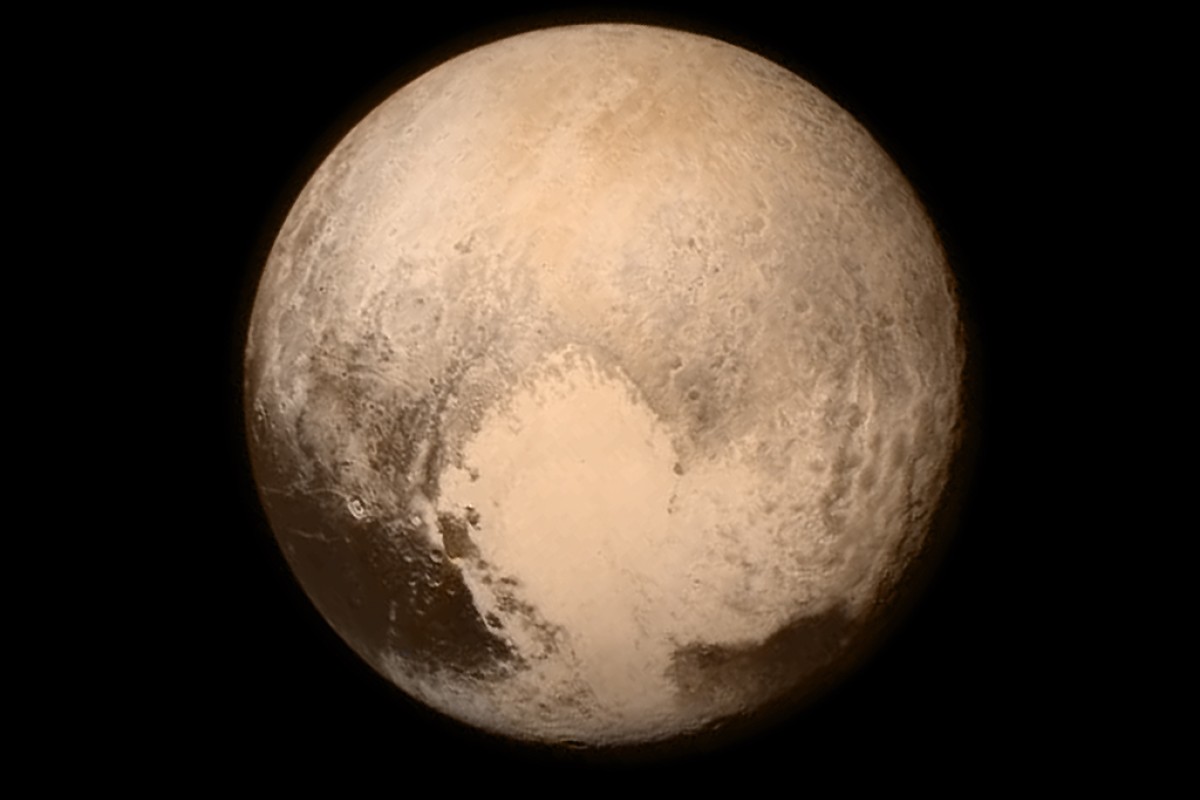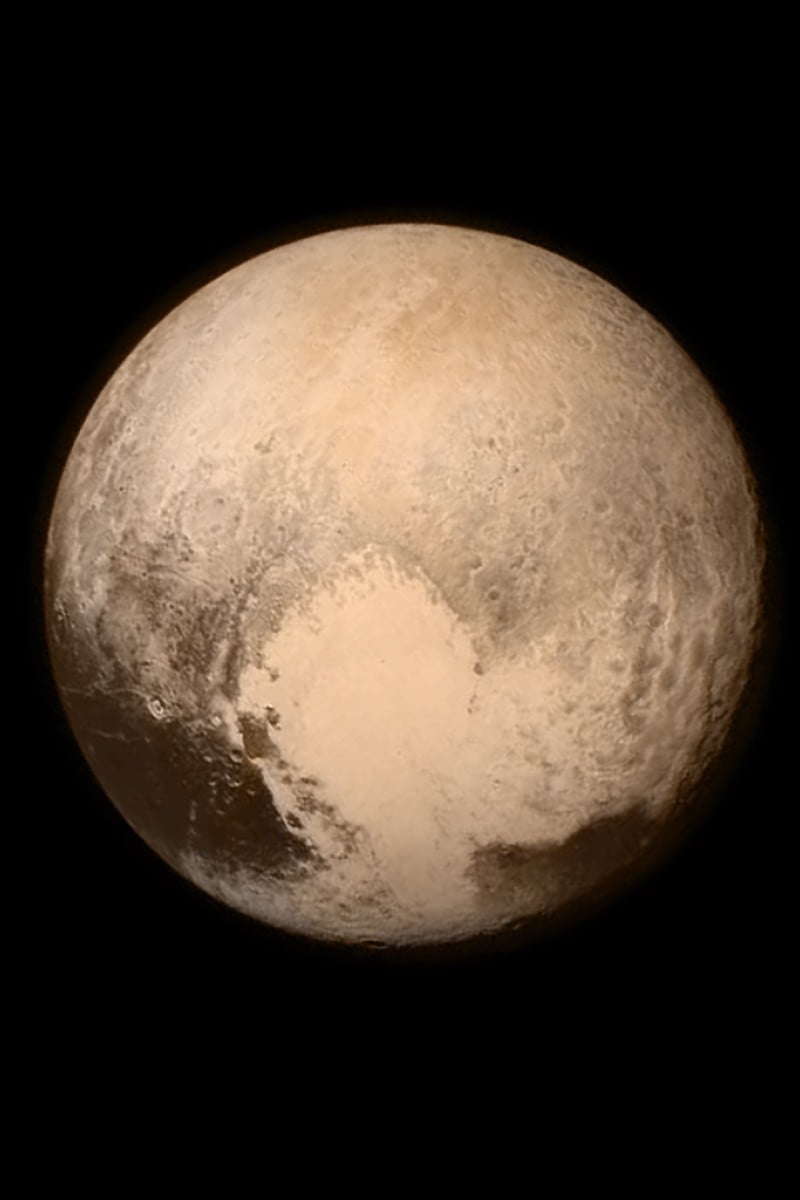 The first few shots of Pluto showed a strange, heart-shaped area.
The first few shots of Pluto showed a strange, heart-shaped area.The first high-resolution images sent back by Nasa’s New Horizons spacecraft are already making scientists rethink their ideas about Pluto and its largest moon, Charon. They used to believe the two were distant, dormant worlds.
The new pictures, released yesterday, show Pluto is home to a large mountain range made of water ice with peaks as high as 11,000 feet - rivaling the Rocky Mountains in size.
On Charon, scientists found a diverse topography that includes cliffs, troughs and a mysterious gash that’s longer and deeper than the Grand Canyon.
Just as notable was something largely missing from these early images: impact craters.
The scarcity of craters suggests that Charon and Pluto have seen geological activity in the relatively recent past that erased the traces of earlier impacts, researchers said.
Scientists knew this was a possibility for Pluto, but it was a real shocker for Charon.
S'prise! - Charon
"We originally though Charon would be an ancient terrain covered in craters," said New Horizons team member Cathy Olkin. "So when we saw the pictures this morning it just blew our socks off."
In addition to revealing the unexpected topography of the Texas-sized moon, the new image provides the best look yet at a mysterious dark region at the northern pole that scientists have unofficially dubbed “Mordor,” a reference to Sauron’s realm in the Lord of the Rings trilogy.
They don’t yet know whether this area is a depression on the moon’s surface or a plateau, but they do think the dark coloring may be a thin veneer of dust or debris - perhaps deposited there after another part of the moon was struck by an alien object.
The new image of Pluto is even more detailed, allowing viewers to pick out features that are just a kilometre across.
The picture reveals a small rectangle of Pluto’s surface at the edge of the recently discovered heart-shaped formation. Measuring about 60km across, it is one frame of a mosaic of high-resolution images that New Horizons captured during its closest approach to the dwarf planet on Tuesday.
Scientists said the ice mountains must have formed in the last 100 million years, making them some of the youngest features in the solar system.
The New Horizons spacecraft beamed the images back to Earth early Wednesday morning, and scientists said they had only nine hours to examine them before presenting them to the world.
It’s already clear that planetary geologists will have their work cut out for them as they try to explain what processes created enough heat to change the surfaces of these two bodies.
Scientists have long known that there is geological activity on the ice moons of Jupiter, Saturn and Neptune, and they have attributed it to the heat generated by the gravitational push and pull of their host planets.
But that explanation won’t work for Pluto.
"This is the first time we’ve seen geology on an icy world that isn’t orbiting a giant plant that can deform it on a regular basis,” said John Spencer, a member of the New Horizons team. “This is telling us that you do not need tidal heating to power geologic activity on icy worlds.”
Maybe there's more!
This insight could change scientists’ view of the Kuiper belt, the vast region beyond Neptune that is dotted with small icy worlds, the largest being Pluto.
Scientists had long thought that these bodies that lie so far from the sun were frozen relics from the dawn of our solar system, keeping the secrets of our origins in a cryogenic freeze.
If they have their own geology, however, that view may have to change
“That is a very important discovery we just made this morning,” Spencer said Wednesday at the Johns Hopkins Applied Physics Laboratory in Laurel, Md., where the mission team is gathered.
Perhaps some of these objects have held onto the heat from their formation, or they may harbor subterranean oceans that are slowly freezing, causing them to expand, the scientists said. They may even contain radioactive elements in their interior that give off heat as they decay.
The close-up of Pluto also makes clear that the dwarf planet has water ice that is as hard as rock is on Earth, said Hal Weaver, New Horizons’ project scientist.
“That is just blowing my mind,” Weaver said. “We had such a hard time finding evidence for water ice on the surface of Pluto, but that is the only way to get those mountains.”
A taste of things to come
The new images are just a small taste of what’s to come, the researchers said. New Horizons will continue to send its highest priority data back to Earth over the next couple of weeks, and mission scientists said they will release even higher-resolution images on Friday. It will take 16 months for all the observations made with New Horizons instruments to reach scientists.
But this initial batch of snapshots could keep them busy for a while.
“Charon has been active and there are mountains in the Kuiper belt,” said Alan Stern, principal investigator for the New Horizons mission. “This system is amazing.”
